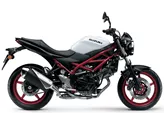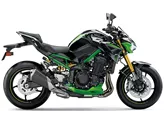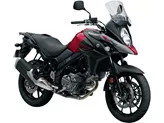Kawasaki Z1000 2014 vs. Suzuki SV 650 2017

Kawasaki Z1000 2014

Suzuki SV 650 2017
Overview - Kawasaki Z1000 2014 vs Suzuki SV 650 2017
The Kawasaki Z1000 model year 2014 and the Suzuki SV 650 model year 2017 are both naked bikes that offer unique features and specifications. Starting with the Kawasaki Z1000 2014, it is equipped with an in-line engine that produces 142 horsepower and 111 Nm of torque. The bike has a four-cylinder configuration and features liquid cooling for optimal performance. With a displacement of 1043 ccm, the Z1000 offers a powerful and thrilling riding experience.
In terms of suspension, the Kawasaki Z1000 2014 is equipped with an upside-down telescopic fork at the front, providing excellent stability and control. The frame of the Z1000 is made of aluminum, which offers a lightweight yet sturdy construction. The braking system consists of double disk brakes with four pistons at the front, ensuring efficient and reliable stopping power.
The dimensions and weights of the Kawasaki Z1000 2014 include a front tire width of 120 mm and a diameter of 17 inches, while the rear tire has a width of 190 mm and the same diameter. The wheelbase measures 1435 mm, providing a stable and balanced ride. The seat height is 815 mm, offering a comfortable riding position for most riders. The fuel tank capacity is 15 liters, allowing for longer rides without frequent refueling.

Kawasaki Z1000 2014
Moving on to the Suzuki SV 650 2017, it is equipped with a V-type engine that produces 76 horsepower and 64 Nm of torque. The bike has a two-cylinder configuration and also features liquid cooling for optimal performance. With a displacement of 645 ccm, the SV 650 offers a smooth and enjoyable riding experience.
In terms of suspension, the Suzuki SV 650 2017 is equipped with a telescopic fork at the front, providing responsive handling and maneuverability. The frame of the SV 650 is made of steel, offering a durable and reliable construction. The braking system consists of double disk brakes with double pistons at the front, ensuring adequate stopping power.
The dimensions and weights of the Suzuki SV 650 2017 include a front tire width of 120 mm and a diameter of 17 inches, while the rear tire has a width of 160 mm and the same diameter. The wheelbase measures 1445 mm, providing stability and control. The seat height is 785 mm, offering a comfortable riding position for most riders. The fuel tank capacity is 13.8 liters, allowing for decent range before refueling.

Suzuki SV 650 2017
In terms of strengths, the Kawasaki Z1000 2014 offers a sophisticated design, extremely pleasant handling, a pleasant sound, and good brakes. On the other hand, the Suzuki SV 650 2017 has a smooth engine, playful handling, and a great chassis.
However, the Kawasaki Z1000 2014 does have a weakness in its high purchase price compared to the Suzuki SV 650 2017. On the other hand, the Suzuki SV 650 2017 has a weakness in its weaker brakes.
In conclusion, both the Kawasaki Z1000 2014 and the Suzuki SV 650 2017 have their own unique features and strengths. The Z1000 offers a more powerful and sporty riding experience, while the SV 650 provides a smoother and more playful ride. Ultimately, the choice between the two will depend on the rider's preferences and priorities.
Technical Specifications Kawasaki Z1000 2014 compared to Suzuki SV 650 2017
Pros and Cons in comparison
Pros and Cons in comparison
Kawasaki Z1000 2014

The Kawasaki Z1000 (2014) is a statement against the electronic trend of its time - and that is exactly what makes it special today. Its characterful four-cylinder engine, mechanical directness and uncompromising focus on the essentials strike a chord in a time when many bikes have become rolling computers. Yes, it does without modern Advanced Rider Assistance Systems and perfect wind protection. But it offers an authentic naked bike riding experience, paired with Japanese reliability and reasonable maintenance costs. The Z1000 is not a bike for data sheet junkies or electronics fans - it is a bike for people who still want to make their own decisions when rider. An honest bike with character that continues to inspire even after years and more than fulfils its role as an emotional alternative to the digital modern age.
Suzuki SV 650 2017

The Suzuki SV 650 is accompanied by a long history of success that is sure to continue for a long time. Its supple V2 impresses with very smooth response and plenty of torque. Compact dimensions help to make the motorbike look very compact. This will be very convenient for beginners. The chassis also scores with playful handling. Unfortunately, the braking effect is not at the level one would expect from such a powerful vehicle.
Price Comparison Avarage Market Price Kawasaki Z1000 vs Suzuki SV 650
There are a few key differences between a Kawasaki Z1000 2014 and a Suzuki SV 650 2017. In terms of price, the actual average price of a Kawasaki Z1000 2014 is about 57% higher. Compared to Suzuki SV 650 2017 there are more Kawasaki Z1000 2014 bikes available on the 1000PS.de Marketplace, specifically 12 compared to 6. It takes less time to sell a Kawasaki Z1000 with 75 days compared to 112 days for a Suzuki SV 650. Since model year 2005 1000PS.de editors have written 41 reviews for the Kawasaki Z1000 and 25 reviews for the Suzuki SV 650 since model year 2005. The first review for the Kawasaki Z1000 was published on 02/09/2002 and now has more than 5,800 views. This compares to more than 14,200 views for the first review on Suzuki SV 650 published on 26/09/2008.




















